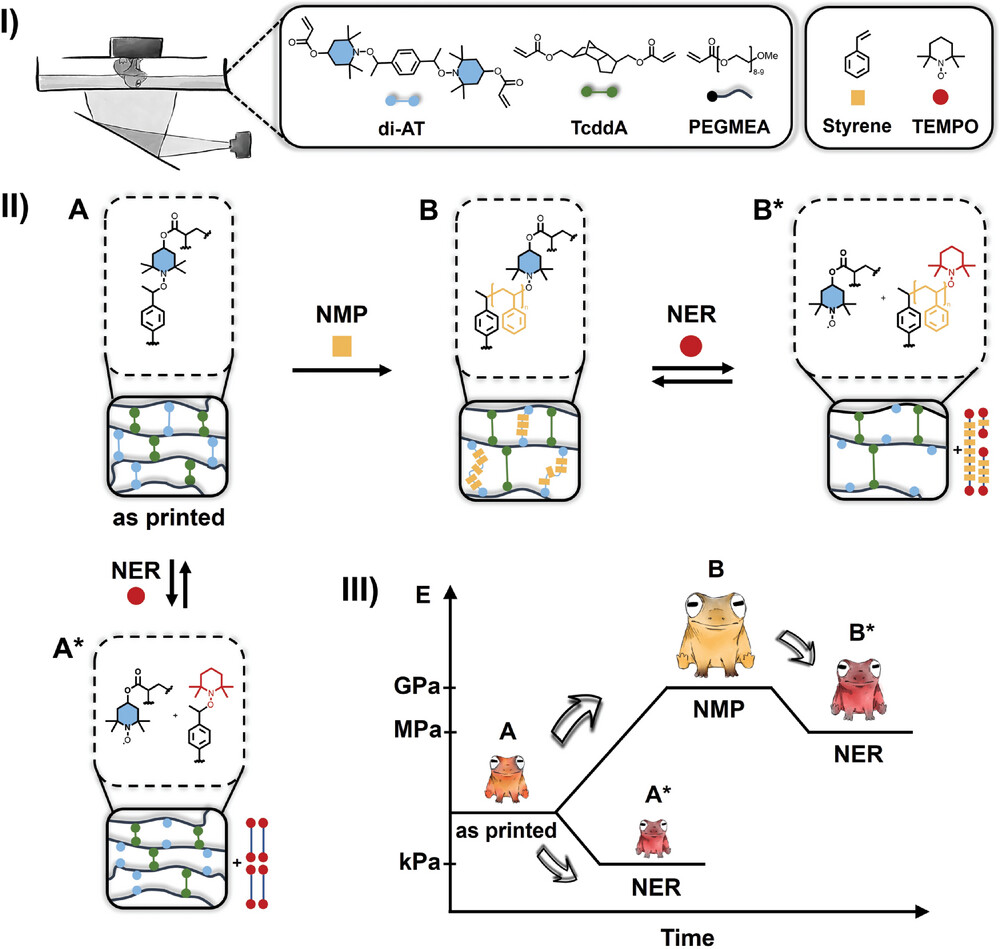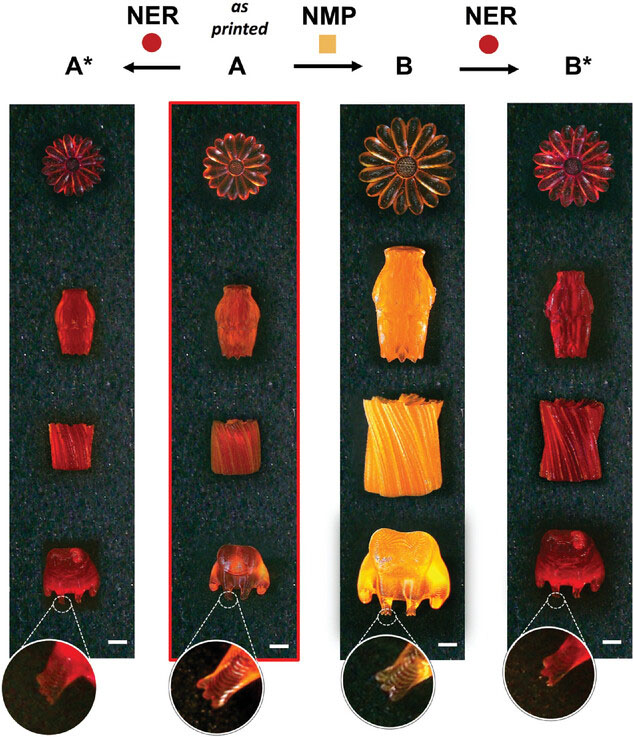| Jan 26, 2024 | |
'Living' 4D printed materials display complex, lifelike adaptability |
|
| (Nanowerk Spotlight) 3D printing technology, also known as additive manufacturing, has rapidly advanced to enable the production of intricate product geometries across industries from aerospace to biomedical. However, expanded capabilities for printed components to be imbued with dynamic, adaptable properties remain constrained. | |
| Now, researchers have developed 3D printable polymer networks based on “living” chemical linkages that can reshape themselves and change properties on demand. This new materials platform unlocks avenues for 4D printing technology to yield complex geometries with programmable shape morphing and tunable mechanics over time. | |
| Since its origins over 30 years ago, 3D printing has transformed design prototyping and manufacturing due to its ability for on-demand fabrication of bespoke shapes without the constraints of traditional molding and machining techniques. | |
| From jetting photopolymers to selectively melting plastics or metal powders layer-by-layer, 3D printers build up components directly from digital models. Recent years have seen remarkable strides to improve speed, resolution and size capabilities. Printed tissue and organ scaffolds, prosthetic limbs, rocket engines and ultralight aircraft components showcase 3D printing’s disruptive potential across industries. | |
| However, expanding the scope of 3D printing requires moving beyond static components to objects that can actively change shape or properties in response to stimuli. This has given rise to an area known as 4D printing over the past decade. 4D printing aims to enable printed “smart” devices and components with built-in functionality that causes them to transform their geometry or other traits when triggered by external factors like humidity, temperature shifts or light. | |
| Early approaches to realize 4D capabilities have incorporated shape memory polymers in filaments or photopolymers that contract when heated past a programmed temperature threshold. Hydrogel matrices containing cellulose fibrils have also been printed to generate structures that unfurl or morph shapes when hydrated. These demonstrate self-actuating printed components with geometry changes linked to narrow triggers. | |
| An enduring challenge has been designing printed materials that can exhibit reversible, adaptive traits allowing for programmable modulation of properties like size, stiffness or surface features over multiple cycles. Dynamic covalent bond chemistry has shown promise to meet this goal. Covalent bonds with reversible connecting and disconnecting capabilities can incorporate self-healing mechanisms or malleable networking capabilities into polymeric materials. | |
| In particular, a chemical linkage known as the alkoxyamine bond has displayed living polymer behavior, meaning polymers containing alkoxyamine crosslinks in their backbone can grow by adding new monomers or shrink by severing chains through application of precise thermal and chemical triggers. | |
| A group of researchers based at Heidelberg University led by chemist Dr. Eva Blasco have now reported using alkoxyamine bonds to create complex 3D printed shapes with unprecedented reversible and adaptive traits. | |
| Published in the journal Advanced Functional Materials ("4D Printing of Adaptable “Living” Materials Based on Alkoxyamine Chemistry"), their study details a new crosslinker molecule containing acrylate and alkoxyamine reactive sites. This crosslinker provides the basis for 3D printable photopolymer resin formulations that solidify into adaptable networks when exposed to light. The team leveraged a high-resolution Digital Light Processing (DLP) 3D printing technique to fabricate intricately detailed centimeter-scale objects with the resin including seed shapes like flowers, vases, cylinders and frogs. | |
 |
|
| 4D printing of adaptable “living” structures. I) Schematic representation of the DLP printing process and ink formulation based on photocross-linkable alkoxyamine species; II) “Multi-way” modification of printed structures A) via nitroxide-mediated polymerization (NMP, B) and nitroxide exchange reaction (NER, A* & B*). III) Schematic representation of the changes in size and mechanical properties of the 4D structures. (Reprinted with permission by Wiley-VCH Verlag) | |
| Critically, the structures maintain their detailed geometries while exhibiting programmable changes in size and mechanical stiffness made possible by the dynamic alkoxyamine sites embedded throughout the material. The researchers demonstrated small molecule and temperature-directed chemistry procedures to both swell and stiffen the printed components by chain extending new polymer growth as well as soften them by severing inserted chains years after initial fabrication. | |
| This “multi-way” adaptability expanded accessible property modulation ranges remarkably from rubbery to glassy behaviors. Printed pieces subjected to their developed nitroxide exchange and polymerization protocols uniformly increased and decreased in volume by over 20% respectively while reduced Young’s modulus values spanned nearly six orders of magnitude from 0.77 megapascals to 1.2 gigapascals. Such dramatic tunability was shown across the range of complex printed geometries. | |
| Analyses using spectroscopy and imaging during the modification processes verified homogeneous changes in chemical composition and network crosslink density supporting the mechanical property shifts. Tests also confirmed changes were precisely confined to the areas designated and completed in a matter of hours with excellent preservation of intricate printed architectures like flower inner ridges and frog finger details despite volume and stiffness fluctuations. | |
| The study underscores alkoxyamine dynamic covalent chemistry’s exceptional utility for enabling 4D printed materials with lifelike adaptability and custom-programmable transformations. While results currently focus on expanding ranges for a single printed material, the modifiable resin platform based on commercially available monomers opens doors for mixing and matching transformation capabilities from a menu of options for future smart devices. | |
| Specifically, the researchers foresee diverse applications from soft actuating robots with optimized locomotion gaits to tissue scaffolds or heart valves with self-optimizing porosity and stiffness as cells proliferate during culture. The technology could also enable vehicles with surfaces or airfoils that actively morph shape during flight to improve speed, efficiency and maneuverability. | |
| Beyond bulk materials, precise dynamic property tuning could be revolutionary for 3D printed electronics by programming conductivity profiles over time. The adaptability could also allow 3D printed components to self-repair accumulated stress damage. Moreover, the living chemistry provides built-in recyclability absent in conventional plastics and composites. | |
 |
|
| 4D “living” complex structures. Photographs of sunflowers, vases, spiral cylinders, and frogs (from top to down): A* = NER modified; A = as-printed; B = NMP modified using styrene and B* = NER modified from B. Scalebar: 2 mm. (Reprinted with permission by Wiley-VCH Verlag) | |
| Looking forward, combining multiple reversible chemistries for orthogonal responses will yield increasingly complex systems reminiscent of nature's intricate biological coordination. Researchers plan to further develop incorporating additional dynamic covalent motifs into printable matrices to approach the sophistication of living organisms. | |
| This new customizable framework deploying Nobel Prize-winning dynamic covalent chemistry provides scientists and engineers an expansive new design palette enabling them to develop the next generation of intelligent systems able to repeatedly self-modify form and performance. | |
| With this new customizable framework deploying Nobel Prize-winning dynamic covalent chemistry, 4D printing offers scientists and engineers an expansive new design palette enabling them to develop the next generation of intelligent systems able to repeatedly self-modify form and performance. | |
 By
Michael
Berger
– Michael is author of three books by the Royal Society of Chemistry:
Nano-Society: Pushing the Boundaries of Technology,
Nanotechnology: The Future is Tiny, and
Nanoengineering: The Skills and Tools Making Technology Invisible
Copyright ©
Nanowerk LLC
By
Michael
Berger
– Michael is author of three books by the Royal Society of Chemistry:
Nano-Society: Pushing the Boundaries of Technology,
Nanotechnology: The Future is Tiny, and
Nanoengineering: The Skills and Tools Making Technology Invisible
Copyright ©
Nanowerk LLC
|
|
|
Become a Spotlight guest author! Join our large and growing group of guest contributors. Have you just published a scientific paper or have other exciting developments to share with the nanotechnology community? Here is how to publish on nanowerk.com. |
|
